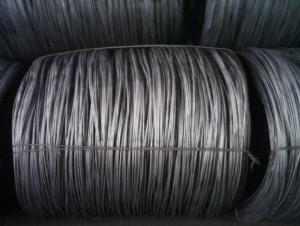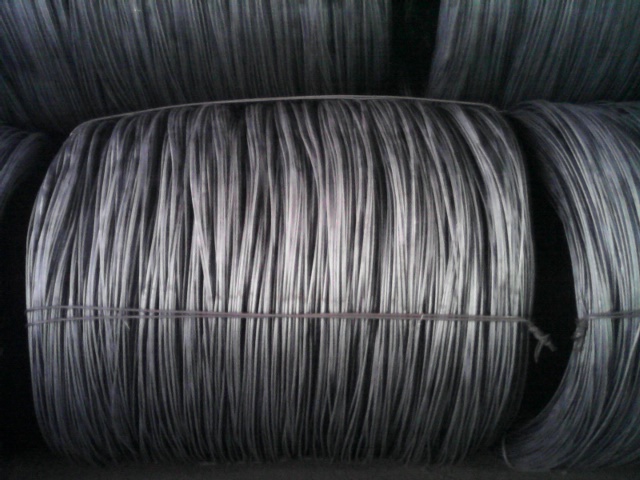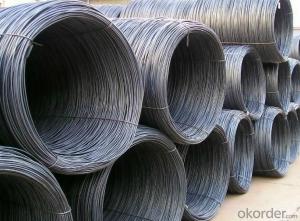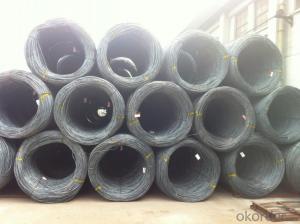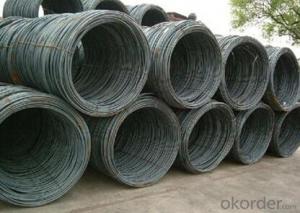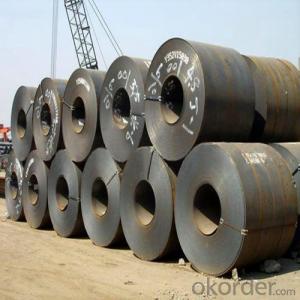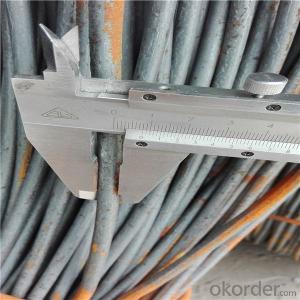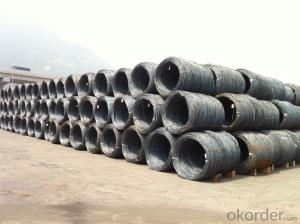Hot Rolled High Quality Wire Rod Coil
- Loading Port:
- China Main Port
- Payment Terms:
- TT or LC
- Min Order Qty:
- -
- Supply Capability:
- -
OKorder Service Pledge
OKorder Financial Service
You Might Also Like
Product Description:
OKorder is offering Wire Rod at great prices with worldwide shipping. Our supplier is a world-class manufacturer of steel, with our products utilized the world over. OKorder annually supplies products to European, North American and Asian markets. We provide quotations within 24 hours of receiving an inquiry and guarantee competitive prices.
Product Applications:
After hot-rolled the products shaped into coil and delivery as finished product, including round, square, rectangular, hexagonal and so on. Since most of the products are round, it is generally called wire rod. Carbon steel wire rod is widely used in construction and manufacturing. Carbon steel wire rod is mainly used for reinforcement of reinforced concrete and welded structure or reprocessed (roberts , nail, etc.) materials, especially used to produce wire drawing, welding electrode, nails, spring, electronic, precise machinery parts and so on.
Product Advantages:
OKorder's Wire Rod are durable, strong, and resist corrosion.
Main Product Features:
· Premium quality
· Prompt delivery & seaworthy packing (30 days after receiving deposit)
· Corrosion resistance
· Can be recycled and reused
· Mill test certification
· Professional Service
· Competitive pricing
Product Specifications:
Steel Grade: Q195/235, SAE1006-1018B Standard: ASTM, GB
Diameter: 5.5mm, 6.5mm, 7mm,8mm,9mm,10mm,12mm,14mm
Type: in coil, coil weight around 2MT Alloy or Not: Alloy
Surface: round, no twisted, light and smooth Chemical Composition: (Please kindly find our chemistry of our material based on Q195、Q235A and Q235B as below for your information)
Grade | Chemical Composition (%) | |||||
C | Mn | S | P | Si | B | |
SAE1008B | 0.10max | 0.32max | 0.045max | 0.040max | 0.30max | 0.0008min |
Mechanical properties | ||||||
Yield strength(N/mm2) | Tensile strength(N/mm2) | Elongation (%) | ||||
≥195 | 350-380 | ≥32 | ||||
Packaging & Delivery of Carbon Steel Wire Rod:
Packaging Detail: products are packed in coil, each coil weight around 2 MT, and then shipped by container or bulk vessel
Delivery Detail: within 45 days after received deposit or LC.
Label: to be specified by customer, generally, each bundle has 1-2 labels
Trade terms: FOB, CFR, CIF
FAQ:
Q1: How soon can we receive the product after purchase?
A1: Within three days of placing an order, we will begin production. The specific shipping date is dependent upon international and government factors, but is typically 7 to 10 workdays.
Q2: What makes stainless steel stainless?
A2: Stainless steel must contain at least 10.5 % chromium. It is this element that reacts with the oxygen in the air to form a complex chrome-oxide surface layer that is invisible but strong enough to prevent further oxygen from "staining" (rusting) the surface. Higher levels of chromium and the addition of other alloying elements such as nickel and molybdenum enhance this surface layer and improve the corrosion resistance of the stainless material.
Q3: Can stainless steel rust?
A3: Stainless does not "rust" as you think of regular steel rusting with a red oxide on the surface that flakes off. If you see red rust it is probably due to some iron particles that have contaminated the surface of the stainless steel and it is these iron particles that are rusting. Look at the source of the rusting and see if you can remove it from the surface.
Images:
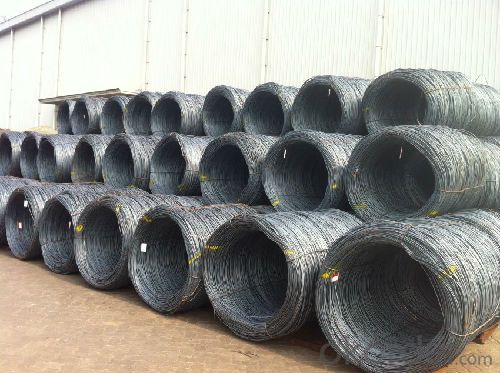
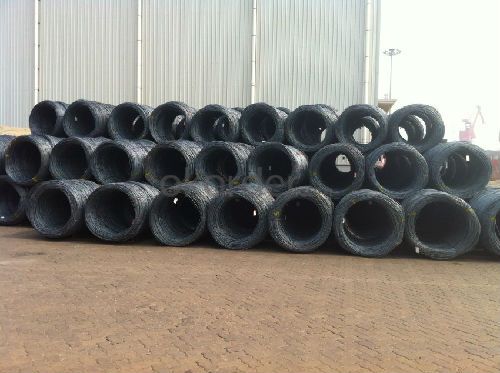
- Q: How is steel wire rod used in the manufacturing of wire for automotive seat frames?
- The manufacturing process of wire for automotive seat frames relies heavily on steel wire rod. This essential material undergoes a series of steelmaking processes, including melting, refining, and casting, to form the wire rod. Afterward, the steel wire rod goes through further processing, such as hot rolling or cold drawing, to achieve the desired shape and size for the wire. Typically, in the production of wire for automotive seat frames, the steel wire rod is fed into a wire drawing machine. This machine pulls the wire rod through a series of dies, gradually reducing the wire's diameter while elongating it. This process enhances the wire's strength, flexibility, and surface finish. The resulting wire is then utilized to construct the seat frames of automobiles. With the help of specialized machinery and techniques, the wire is bent and shaped into the desired form. It is commonly used to create the seat's structural framework, providing it with the necessary strength and stability. The use of steel wire rod in the manufacturing of wire for automotive seat frames offers various advantages. Firstly, steel is a strong and durable material, ensuring that the seat frames can withstand the stresses and forces encountered during use. Additionally, steel wire is highly flexible, allowing for easy shaping and forming into intricate designs required for seat frames. Moreover, steel wire possesses excellent corrosion resistance properties, ensuring the seat frames remain in good condition for an extended period. Furthermore, steel wire rod is a cost-effective material choice for automotive seat frames. Steel is abundantly available and has relatively low production costs compared to other materials. This makes it an attractive option for manufacturers seeking to produce seat frames at a reasonable price without compromising quality or performance. In conclusion, steel wire rod plays a crucial role in the manufacturing of wire for automotive seat frames. Its strength, flexibility, corrosion resistance, and cost-effectiveness make it an ideal material choice. By utilizing steel wire rod, manufacturers can produce high-quality seat frames that meet the rigorous standards of the automotive industry.
- Q: How is steel wire rod used in the manufacturing of mattress springs?
- Steel wire rods are used in the manufacturing of mattress springs as they provide a strong and durable support system. These rods are formed into coils, which are then interconnected to create the spring structure that offers optimal comfort and support to the mattress.
- Q: What are the different types of steel wire rod?
- There are several different types of steel wire rods, including low carbon, medium carbon, high carbon, alloy, and stainless steel wire rods.
- Q: How is steel wire rod used in the manufacturing of wire forms for fishing nets?
- Steel wire rod is a crucial component in the manufacturing of wire forms for fishing nets. The wire rod serves as the raw material from which the wire forms are created. Firstly, the steel wire rod is processed through a series of steps to transform it into a usable wire form. This includes cleaning, annealing, and drawing the wire rod to achieve the desired diameter and tensile strength. These processes ensure that the wire is strong and flexible enough to withstand the tension and stress it will experience when used in fishing nets. Once the wire rod is transformed into wire, it is then used to create the various wire forms required for fishing nets. These wire forms include various components such as hoops, rings, loops, and connectors that are essential for constructing a functional fishing net. The wire forms are created using specialized machinery and techniques, including bending, cutting, and welding the wire according to the specific design requirements. These wire forms are then assembled together to form the net structure. The use of steel wire rod in the manufacturing of wire forms for fishing nets provides numerous advantages. Steel is known for its high strength and durability, making it ideal for withstanding the harsh conditions and constant tension that fishing nets are subjected to. Additionally, steel wire rod is resistant to corrosion, ensuring that the wire forms will have a long lifespan even when exposed to water and other environmental factors. In conclusion, steel wire rod is a vital component in the manufacturing of wire forms for fishing nets. It serves as the raw material from which the wire forms are created, providing the necessary strength, flexibility, and durability required for a functional fishing net.
- Q: What are the common industry guidelines for steel wire rod manufacturers?
- The common industry guidelines for steel wire rod manufacturers typically include standards for product dimensions, chemical composition, mechanical properties, surface quality, and packaging. Additionally, manufacturers are often expected to comply with safety, environmental, and labor regulations, as well as industry-specific quality management systems. These guidelines ensure consistent and reliable production of steel wire rods that meet the required specifications and performance standards.
- Q: What are the different sizes and diameters available for steel wire rod?
- Steel wire rods are available in various sizes and diameters to cater to different applications and industries. The sizes and diameters of steel wire rods typically range from 5.5mm to 20mm, with common sizes being 6mm, 8mm, 10mm, 12mm, and 16mm. The diameter of a steel wire rod refers to the thickness or width of the rod, which determines its strength and load-bearing capacity. The specific diameter required depends on the intended use of the wire rod. Thicker diameters are often used for heavy-duty applications such as construction, while thinner diameters are suitable for lighter applications like fencing or wire mesh. Manufacturers produce steel wire rods with a variety of diameters to meet the diverse needs of industries such as construction, automotive, manufacturing, and agriculture. Depending on the specific requirements of a project or application, customers can choose the appropriate size and diameter of steel wire rod to ensure optimal performance and durability.
- Q: How is steel wire rod cut to desired lengths?
- Steel wire rod is typically cut to desired lengths using a process called wire drawing. Wire drawing involves pulling the steel rod through a series of dies, which gradually reduce its diameter. This process not only shapes the wire to the desired size but also increases its strength and flexibility. The wire drawing process can be done manually or using automated machinery, depending on the scale of production. Once the wire has been drawn to the desired diameter, it can be cut into specific lengths using various cutting methods such as shearing or sawing. These cutting methods can be performed manually or by using specialized cutting equipment. Overall, the process of cutting steel wire rod to desired lengths involves wire drawing to shape the wire and then cutting it using appropriate cutting methods.
- Q: How are steel wire rods used in the production of electrical wires for conducting electricity?
- Steel wire rods are an essential component in the production of electrical wires for conducting electricity. These wire rods serve as the core material around which the electrical wires are manufactured. To begin with, the steel wire rods are carefully selected for their high tensile strength and conductivity properties. This ensures that the resulting electrical wires are strong, durable, and efficient in conducting electricity. The first step in the production process involves drawing the steel wire rods through a series of dies to reduce their diameter. This process is known as wire drawing and is used to achieve the desired thickness and shape of the electrical wire. By reducing the diameter, the wire becomes more flexible and easier to handle during installation. Once the wire rods have been drawn to the required size, they are then coated with a layer of insulating material. This insulation is crucial for preventing electrical leakage, short circuits, and protecting against external factors that may damage the wire. Common insulation materials used include PVC (polyvinyl chloride), XLPE (cross-linked polyethylene), or rubber. After the insulation process, the wire rods are further processed to include any necessary additional features. For instance, they may be twisted together to form multi-conductor cables, or copper strands may be added to enhance the wire's conductivity. These additional steps are performed based on the specific requirements of the electrical wire. Finally, the wire rods are wound onto spools or coiled into reels, ready to be used in various electrical applications. These can range from domestic wiring systems to industrial power distribution networks. In summary, steel wire rods play a vital role in the production of electrical wires. They provide the core material around which the wires are manufactured, ensuring strength, durability, and efficient conductivity. Through wire drawing, insulation, and other processing steps, the wire rods are transformed into high-quality electrical wires that are essential for conducting electricity safely and effectively.
- Q: What are the safety precautions to be taken while handling steel wire rod?
- When handling steel wire rods, it is important to follow certain safety precautions to avoid accidents or injuries. Here are some key safety measures to consider: 1. Personal Protective Equipment (PPE): Wear appropriate PPE, including protective gloves, safety glasses, and steel-toed boots. This will help protect against cuts, bruises, and eye injuries. 2. Proper Lifting Techniques: Use proper lifting techniques when handling steel wire rods to prevent strain or back injuries. Lift with your legs, not your back, and avoid twisting motions while lifting or carrying the rods. 3. Secure Storage: Store steel wire rods in a designated area that is well-organized and secure. This will prevent them from falling or rolling, which can cause injuries. 4. Clear Pathways: Keep pathways clear of obstructions, ensuring a safe and unobstructed route for transporting the rods. This will minimize the risk of tripping or slipping accidents. 5. Inspect for Defects: Before handling steel wire rods, inspect them for any defects or sharp edges. Remove any damaged or defective rods from use to prevent injuries. 6. Proper Handling Equipment: Use appropriate handling equipment, such as forklifts or trolleys, when moving or transporting steel wire rods. Ensure that the equipment is in good working condition and operated by trained personnel. 7. Teamwork and Communication: When working in a team, communicate effectively with your colleagues to avoid accidents. Use clear signals or verbal cues to coordinate movements and ensure everyone is aware of their surroundings. 8. Adequate Lighting: Ensure that the work area is well-lit to provide good visibility and minimize the risk of accidents due to poor lighting conditions. 9. Training and Awareness: Provide proper training to all personnel involved in handling steel wire rods. Educate them about the potential hazards, safe handling techniques, and emergency procedures. 10. First Aid Preparedness: Have a well-stocked first aid kit available, and ensure that employees are trained in basic first aid in case of any injuries. By following these safety precautions, you can help minimize the risk of accidents, injuries, and damage when handling steel wire rods. Always prioritize safety and take necessary measures to protect yourself and others in the workplace.
- Q: What are the different types of steel wire rod surface defect repair and rework procedures?
- There are several types of steel wire rod surface defect repair and rework procedures, depending on the specific defect and its severity. Some common procedures include grinding, polishing, and buffing to remove minor surface imperfections such as scratches or roughness. For more significant defects like cracks or dents, welding or brazing may be used to repair the damaged area. In some cases, the wire rod may need to undergo a complete rework process, involving cutting and reshaping the affected section, followed by heat treatment to restore its mechanical properties. Overall, the type of repair procedure used depends on the nature of the defect and the desired quality of the final product.
Send your message to us
Hot Rolled High Quality Wire Rod Coil
- Loading Port:
- China Main Port
- Payment Terms:
- TT or LC
- Min Order Qty:
- -
- Supply Capability:
- -
OKorder Service Pledge
OKorder Financial Service
Similar products
Hot products
Hot Searches
Related keywords
